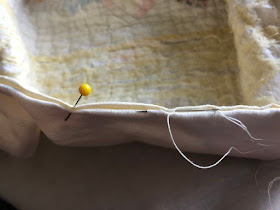Here is a solution I have devised for giving a such a quilt enough support and stabilization to let the family handle and enjoy it more safely.
This is a 1930s Dresden plate. As you can see, the fabric is quite worn. It's like this over the whole surface of the quilt.
Along the edges, there are rips and areas where all three layers are missing.
Here's the quilt in my basting frame on its new back fabric. (The frame is supported by four chairs, and made from four pieces of 1x4" lumber sealed with a wood sealer, heavy-weight muslin attached to the wood, and 4 c-clamps. The back fabric is pinned to the muslin.)
Where fabric was missing, I added a pale yellow cotton, slipping it between the quilt and the backing. This not only improves the appearance, it also gives more thickness and strength to those areas. Then I basted the edges all around the quilt, and basted the edges of the torn places.
I tie the quilt to its new back, usually with perle cotton. I stitch the ties so that the tie ends are on the back of the quilt so that they don't change the appearance of the quilt.
I get quite a bit of bending and stretching and crawling exercise during this part of the process! Here's the quilt from below. (I draped sheets over the edges just for the photos, so the ties hanging down from the quilt are visible.)
On the rest of the edges, I turned the backing edge under and appliquéd it to the back of the quilt itself, also with a ladder stitch.
Here is the finished look at the places where all three layers had been missing. You can see how the large herringbone stitch holds the torn edges in place.
The quilt belongs to the mother of the man who brought it to me. She is about to turn 95 years old. She acquired the quilt on a visit to family in the Asheville, NC, area in the 1940s. Her relatives there, the Rockett family, gave her this quilt so she could take it back home to Michigan. They figured she'd make good use of it up north where the winters are colder. That she has, and the quilt is now an important family heirloom.

















No comments:
Post a Comment